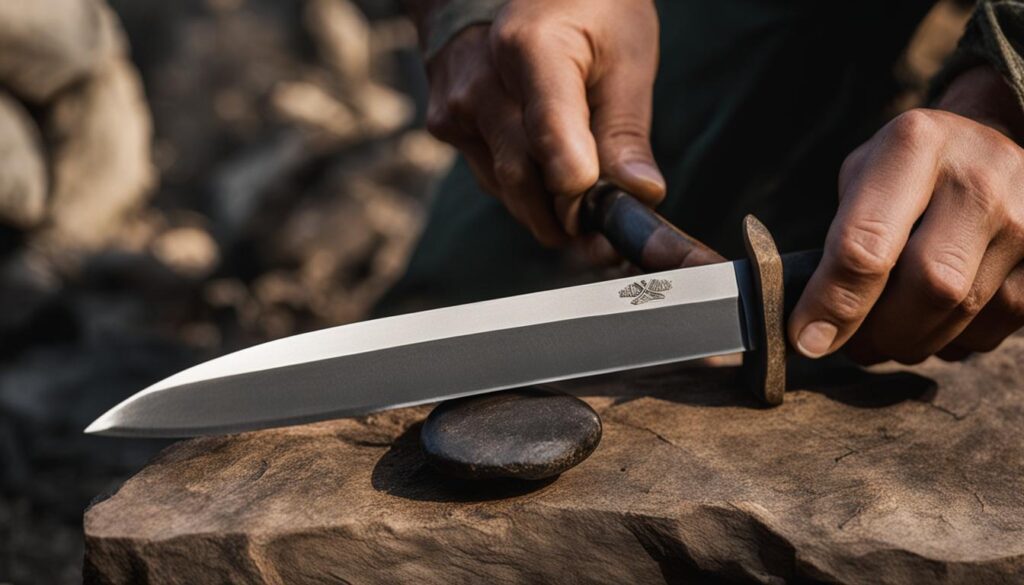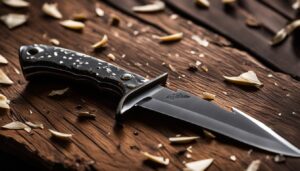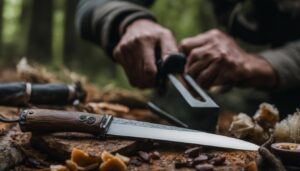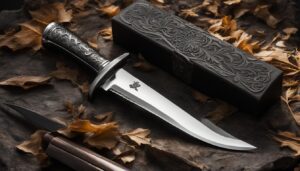Hunting knives are an essential tool for any hunter, but they can lose their sharpness over time. Sharpening a hunting knife is crucial for maintaining its performance and ensuring safe and efficient use in the field. Different types of hunting knives require different sharpening techniques, and there are various sharpening tools available such as sharpening stones, honing rods, electric sharpeners, pull-through sharpeners, and guided sharpening systems. Preparing the hunting knife, such as cleaning the blade and determining the correct sharpening angle, is also important before starting the sharpening process. The best way to sharpen a hunting knife using a whetstone involves holding the stone securely and applying light pressure while moving the blade back and forth at a consistent angle. Regular maintenance and care, such as using a honing rod, storing the knife properly, and sharpening it regularly, also help to keep the hunting knife sharp for longer periods of time.
Key Takeaways:
- The best way to sharpen hunting knives is by using a whetstone.
- Different types of hunting knives require specific sharpening techniques.
- Sharpening tools such as sharpening stones, honing rods, electric sharpeners, pull-through sharpeners, and guided sharpening systems are available.
- Proper maintenance and care of hunting knives are essential for maintaining sharpness and performance.
- Regular sharpening and use of a honing rod can help keep hunting knives sharp for longer.
How the Type of Knife Affects the Sharpening Process
The type of hunting knife you have plays a significant role in the sharpening process. Different blade designs require different sharpening techniques to achieve optimal results. Here are some examples of how different types of hunting knives can affect the sharpening process:
- A drop point knife with a curved edge may require a sharpening stone or honing rod with a rounded edge to follow the blade’s curve.
- A clip point knife with a straight edge can be sharpened using a straight-edged sharpening stone or honing rod.
- A gut hook knife with a unique shape requires special attention to sharpen the hook’s edge separately.
- A Bowie knife with a long and curved blade may require a longer sharpening stone or honing rod.
- A skinning knife with a narrow blade may need a fine-grit sharpening stone or honing rod to maintain a sharp edge without removing too much material.
Each blade design has its own characteristics that require specific sharpening techniques. By understanding the type of knife you have, you can choose the appropriate sharpening tools and methods to achieve the best results.
When it comes to sharpening hunting knives, precision is key. Knowing how the type of knife affects the sharpening process allows you to tailor your approach accordingly, ensuring that you achieve a sharp and durable edge for your specific knife design.
Table: Blade Designs and Sharpening Techniques
| Knife Type | Blade Design | Recommended Sharpening Technique |
|---|---|---|
| Drop point knife | Curved edge | Sharpening stone or honing rod with a rounded edge |
| Clip point knife | Straight edge | Straight-edged sharpening stone or honing rod |
| Gut hook knife | Unique shape with a hook | Special attention required to sharpen the hook’s edge separately |
| Bowie knife | Long and curved blade | Longer sharpening stone or honing rod |
| Skinning knife | Narrow blade | Fine-grit sharpening stone or honing rod |
Each knife type has its own sharpening requirements to achieve optimal performance. By selecting the appropriate sharpening technique for your specific blade design, you can ensure that your hunting knife remains sharp and ready for any outdoor adventure.
Different Types of Sharpening Tools
When it comes to sharpening hunting knives, there are various types of sharpening tools available to choose from. Each tool has its own advantages and specific techniques for achieving a sharp edge. Understanding the different options can help you select the right tool for your needs.
One popular sharpening tool is the sharpening stone, also known as a whetstone. This traditional tool comes in different materials such as natural stone or synthetic abrasives. Sharpening stones require the application of either oil or water before use, and they provide a versatile and effective way to sharpen hunting knives.
Another tool commonly used for sharpening knives is the honing rod. A honing rod is a long, cylindrical rod made of steel or ceramic. It is used to realign and straighten the blade’s edge, making it a great tool for maintaining an already sharp knife. By running the blade along the honing rod at the correct angle, you can keep your hunting knife performing at its best.
If you’re looking for a more convenient and efficient option, an electric sharpener may be the right choice for you. Electric sharpeners feature abrasive belts or discs that grind away dull areas on the blade’s edge. They are quick and easy to use, but it’s important to follow the manufacturer’s instructions to avoid removing too much material from the blade.

How To Sharpen A Hunting Knife Using A Whetstone
Sharpening a hunting knife using a whetstone is an essential skill that every hunter should master. Not only does it help maintain the knife’s sharpness, but it also ensures safe and efficient use in the field. The process may seem daunting at first, but with practice and the right technique, you can achieve a razor-sharp edge that will enhance your hunting experience.
To begin sharpening a hunting knife with a whetstone, secure the stone on a flat surface using a non-slip mat or by placing it in a stable holder. Start by determining the desired sharpening angle, typically between 20 to 30 degrees, depending on the knife’s blade geometry. Holding the knife at this angle, place the blade against the whetstone, ensuring that the entire cutting edge makes contact with the stone.
Using light pressure, move the blade back and forth along the stone in a sweeping motion. Maintain a consistent angle and apply even pressure throughout the sharpening process. Start with the coarse side of the whetstone to remove any nicks or dull spots on the blade. Once you have established a sharp edge, switch to the finer side of the stone for a more refined finish.
It’s important to alternate between sharpening both sides of the blade to ensure an even edge. After several passes on each side, check the knife’s sharpness by gently running it across a piece of paper or by performing a thumbnail test. If the blade slices through the paper smoothly or catches on your thumbnail without slipping, you have achieved a sharp edge.
| Benefits of Sharpening a Hunting Knife Using a Whetstone |
|---|
| 1. Precise control over the sharpening process. |
| 2. Longer-lasting sharpness compared to other sharpening methods. |
| 3. Versatility for different types of hunting knives. |
| 4. Ability to customize the sharpening angle for optimal performance. |
“Sharpening a hunting knife using a whetstone allows me to maintain complete control over the sharpening process. I can fine-tune the angle and achieve a razor-sharp edge that lasts longer than other methods. It’s an essential skill every hunter should learn.” – Experienced Hunter
After sharpening the hunting knife using a whetstone, it’s essential to remove any burrs or wire edges that may have formed during the sharpening process. This can be done by gently stroking the blade along a honing rod, which helps align the edge and remove any imperfections. Finally, wipe the blade clean to remove any residue, and consider applying a light coating of oil to protect it from rust and corrosion.
In addition to sharpening with a whetstone, some hunters also incorporate a leather strop into their sharpening routine. A leather strop helps refine the edge further, creating an incredibly sharp and polished finish. Simply run the blade along the leather surface, ensuring it makes consistent contact, to achieve optimal sharpness.


By mastering the art of sharpening a hunting knife using a whetstone, you can ensure your blade remains sharp and ready for any hunting adventure. Regular maintenance and care, including proper storage and regular sharpening, are essential for maintaining a sharp edge and optimal performance in the field. Remember, practice makes perfect, so don’t be discouraged if your first attempts aren’t perfect. With time and patience, you’ll become proficient in sharpening your hunting knife, allowing you to experience the full potential of your trusted tool.
Conclusion
Sharpening hunting knives is an essential skill for maintaining a sharp edge and achieving optimal performance. By mastering the art of sharpening, I can ensure that my hunting knife remains in top condition, ready for any outdoor adventure.
Understanding the specific sharpening requirements of different types of knives is crucial. By using the right sharpening tools and following proper techniques, I can effectively maintain the sharpness of my knife and ensure its durability in the field.
Regular maintenance and care, such as using a honing rod, storing my knife properly, and sharpening it regularly, are key factors in keeping the blade sharp for longer periods of time. By incorporating these practices into my routine, I can enjoy the benefits of a reliable and efficient hunting knife.
With patience, practice, and the right techniques, I can continue to improve my sharpening skills and enhance my overall hunting experience. A sharp hunting knife is not only a tool but also a valuable asset that contributes to my success and safety in the great outdoors.
FAQ
What is the best way to sharpen a hunting knife?
The best way to sharpen a hunting knife is by using a whetstone. Holding the stone securely on a flat surface, apply light pressure while moving the blade back and forth at a consistent angle. Repeat on both sides of the blade, alternating between sides and increasing pressure slightly with each pass.
How often should I sharpen my hunting knife?
It is recommended to sharpen your hunting knife regularly, especially if you use it frequently. The frequency of sharpening depends on the usage and the type of knife, but a good rule of thumb is to sharpen it after every few uses or whenever you notice a decrease in performance.
Can I use an electric sharpener to sharpen my hunting knife?
Yes, you can use an electric sharpener to sharpen your hunting knife. However, it is important to use the correct technique and avoid removing too much material from the blade. Follow the manufacturer’s instructions and be cautious with the pressure applied to the blade during the sharpening process.
How do I determine the correct sharpening angle for my hunting knife?
The correct sharpening angle for your hunting knife depends on the type of knife and its intended use. In general, a sharpening angle between 20 to 30 degrees is suitable for most hunting knives. However, some specialized knives may require a different angle, so it is best to refer to the manufacturer’s recommendations or consult an expert if unsure.
Can I sharpen a gut hook knife using the same technique as other hunting knives?
No, sharpening a gut hook knife requires special attention. The gut hook’s edge should be sharpened separately from the main blade. Use a sharpening stone or honing rod to sharpen the gut hook, ensuring to follow its unique shape while maintaining the correct angle.
How should I store my hunting knife to maintain its sharpness?
To maintain the sharpness of your hunting knife, store it in a dry and clean environment. Avoid placing it with other metal objects that can cause scratches or damage. It is also recommended to store the knife in a sheath or blade guard to protect the edge and prevent accidental cuts.
Do I need to use a honing rod in addition to sharpening my hunting knife?
Using a honing rod in addition to sharpening your hunting knife can help maintain its sharpness and straighten the blade’s edge. A honing rod removes any remaining burrs and polishes the blade, resulting in a finer edge. It is a good practice to use a honing rod regularly to keep your hunting knife in optimal condition.
What is the purpose of a leather strop in the sharpening process?
A leather strop is used as a final step in the sharpening process to refine the edge of the blade. It helps remove any remaining burrs and further polish the blade, resulting in a sharper and smoother cutting edge. Running the blade along a leather strop can improve the overall performance and longevity of your hunting knife.





